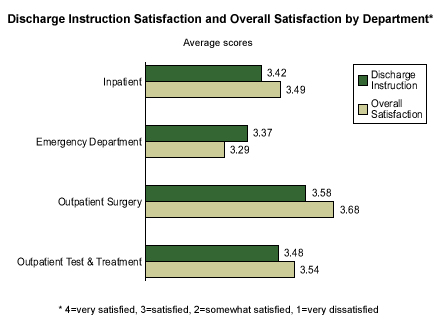A patient enters a healthcare facility for diagnosis and treatment, ultimately seeking better health. But a patient may spend as little as one day in an inpatient setting, or as little as an hour in an outpatient setting. Is this long enough to achieve a desired health outcome? The best answer is maybe. Success usually depends on what the patient and the patient's family do after they leave the healthcare-provider setting -- and what they do is dependent upon the quality of discharge instructions provided by the staff.
Satisfaction With Discharge Instructions
How satisfied are patients with their discharge instructions? According to the 2001 Â鶹´«Ã½AV Patient Database, hospital patients tend to be most satisfied with outpatient-surgery discharge instructions and least satisfied with emergency-department discharge instructions. Inpatient and outpatient test and treatment scores fall somewhere in between. These findings parallel the overall satisfaction results in each of these healthcare delivery areas.

The mean scores for satisfaction with discharge instructions provide only part of the picture. While satisfaction with emergency-department discharge instructions is lowest in an absolute sense, it is the only area in which satisfaction with discharge instructions exceeds overall satisfaction. Conversely, the greatest gap between overall satisfaction and discharge instruction satisfaction is found in outpatient surgery.
The percentage of patients who are very satisfied with discharge instructions (giving a score of "4" on a 1 to 4 scale) ranges from 46% for the emergency department to 62% for outpatient surgery. Once again, inpatients (49%) and outpatient surgery patients (52%) fall in the middle. Opportunity for improvement exists in all of these care settings.
How to Improve Satisfaction With Discharge Instructions
In consulting with healthcare clients on this item, I have noticed several ways that healthcare providers can improve their performance when delivering discharge instructions.
1. Track "day after" patient telephone calls.
Discharge instructions are often the last thing that patients and families receive before leaving the care setting. They may not realize that they don't understand the instructions until they arrive home. At that point, the only recourse is to call the provider for clarification.
All patient and family calls should be logged and tracked. Frequently asked questions represent poor communication during the discharge-instruction process and those points of communication should be reviewed. The communication strategy should answer questions before they are asked.
2. Include the family or caregiver when delivering discharge instructions.
Medication, advanced age or other factors may render a patient unable to retain discharge instructions. Therefore, family members/caregivers should be incorporated into this process.
3. Do not be overly dependent on written discharge instructions.
Written instructions and other materials should be used as visual aids during the discharge process. They are important teaching tools and help patients recall instructions once they're home. But written instructions should never be a substitute for active teaching by the staff. I have often observed high discharge instruction satisfaction at organizations that have poor written instructions, but staff who compensate by providing excellent verbal teaching.
4. Teach, don't lecture.
Discharge instruction is interactive teaching. To ensure the patient and family understand, have them repeat back the instructions or perform the procedures that they must do at home. Above all, solicit questions to ensure understanding.
5. Discharge instruction does not begin at the point of discharge.
In emergency settings, patients are receiving unanticipated care and therefore can only receive discharge instructions at the end of the visit. However, many other treatments are scheduled in advance. For scheduled inpatient or outpatient surgeries, discharge education should begin with pre-surgery testing. This will not occur accidentally; it must be planned and initiated by the care-setting staff in conjunction with the physician office. Expectant mothers in particular, who are able prepare for their hospital stays months in advance, can begin the discharge education process much earlier.
Key Points
A patient's understanding of discharge instructions is vital to the success of any medical procedure. Therefore, patient satisfaction on this item is closely linked to the ultimate improvement of a patient's health. Patient satisfaction with discharge instructions varies by delivery setting, and is generally lower than overall patient satisfaction. To improve satisfaction with discharge instructions, healthcare providers should focus on delivering instructions to both the patient and family in an informative, interactive manner, as well as on introducing discharge instructions as early as possible during the patient care experience.